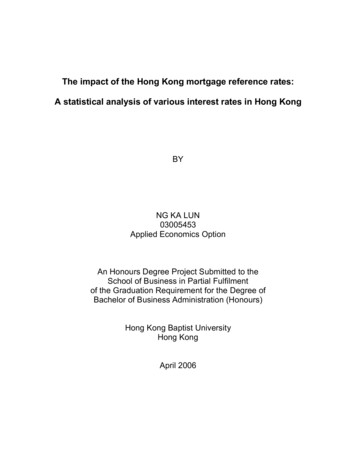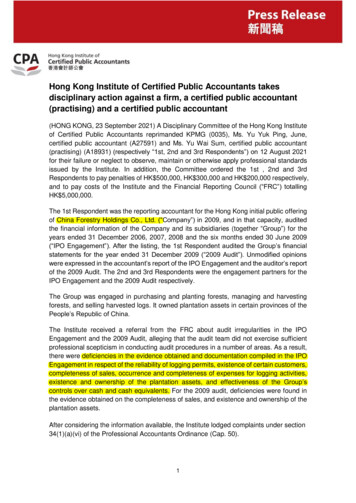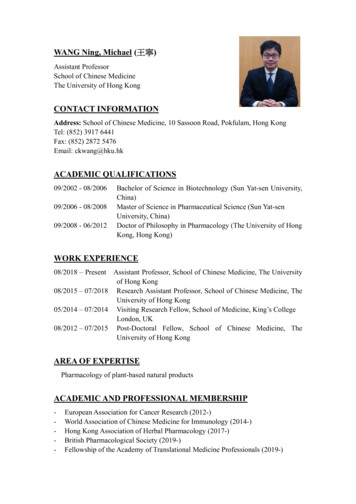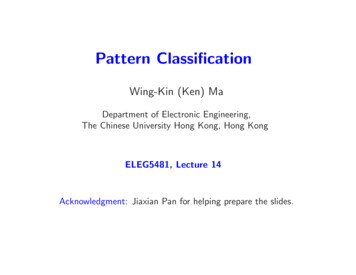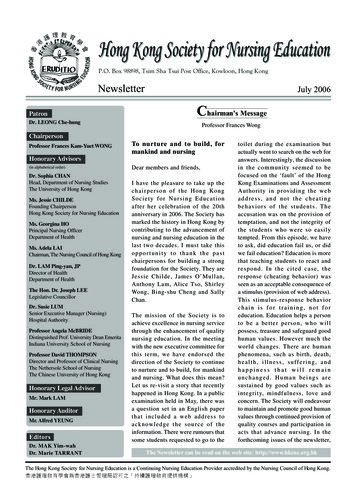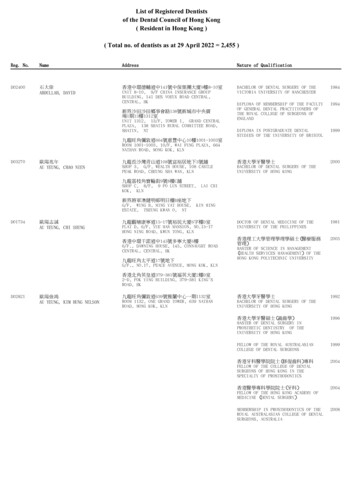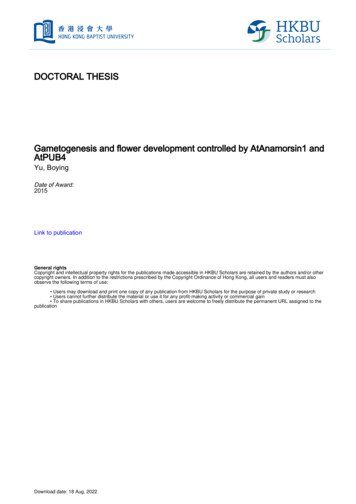
Transcription
Hong Kong Baptist UniversityDOCTORAL THESISGametogenesis and flower development controlled by AtAnamorsin1 andAtPUB4Yu, BoyingDate of Award:2015Link to publicationGeneral rightsCopyright and intellectual property rights for the publications made accessible in HKBU Scholars are retained by the authors and/or othercopyright owners. In addition to the restrictions prescribed by the Copyright Ordinance of Hong Kong, all users and readers must alsoobserve the following terms of use: Users may download and print one copy of any publication from HKBU Scholars for the purpose of private study or research Users cannot further distribute the material or use it for any profit-making activity or commercial gain To share publications in HKBU Scholars with others, users are welcome to freely distribute the permanent URL assigned to thepublicationDownload date: 18 Aug, 2022
Gametogenesis and Flower Development Controlled byAtAnamorsin1 and AtPUB4YU BoyingA thesis submitted in partial fulfilment of the requirementsfor the degree ofDoctor of PhysiologyPrincipal Supervisor: Prof. XIA YijiHong Kong Baptist UniversityJanuary 2015
DeclarationI hereby declare that this thesis represents my own work which has been doneafter registration for the degree of Ph.D at Hong Kong Baptist University, and hasnot been previously included in a thesis, dissertation submitted to this or otherinstitution for a degree, diploma or other qualification.Signature:Date: January 2015i
AbstractFlowers are the organs for sexual reproduction in angiosperms. Gametogenesisin floral organs leads to formation of sperms and eggs and their fertilization formsa zygote that develops into a new plant. Gametogenesis and embryogenesisinvolve precisely regulated biological processes controlled by complex networksof genes and pathways.In this study, AtANA1, which was identified as a redox sensitive protein inprevious study, was found to be essential for embryogenesis and also plays animportant role in both male and female gametogenesis. Without a functionalAtANA1, embryo development is arrested after the first cell division of the zygote.The ana1 mutation also causes arrest in different steps of male and femalegametogenesis. Aborting pollen and embryos caused by the ana1 mutation exhibitenhanced accumulation of reactive oxygen species and DNA fragmentation,marks of programmed cell death. Presence of aborting ana1 pollen was also foundto lead to abortion of wild type pollen in the same anther, raising a possibility thatthe aborting ana1 pollen might release a death signal. ANA1 could be involved inan oxidative stress signaling pathway, and loss of its function triggers death ofgametophytic and embryonic cells.Another important protein involved in Arabidopsis reproductive processes isPUB4, an E3 ubiquitin ligase. The pub4 mutation was previously found to causeabnormal enlargement of tapetal cells and incomplete degeneration of the tapetumlayer, resulting in a defect in pollen release and conditional male sterility. In thisstudy, we characterized PUB4’s role in controlling floral meristem determinacy.The pub4 mutation causes formation of ectopic floral organs inside ofcarpels/siliques. It was found that the pub4 mutation leads to ectopic expression ofWUSCHEL, an important regulator which is essential for maintaining shoot apicalmeristem and floral meristem, which could be responsible for the flower-in-flowerphenotype. PUB4 appears to work additively with AGAMOUS (AG) to controlappropriate expression of the WUS gene. Three extra large G proteins (XLGs) inArabidopsis, which interact with PUB4, also play roles in controlling tapetal cellenlargement and degeneration. However, XLGs might not function in floralmeristem determinacy.ii
AcknowledgementsForemost, I would like to show my sincere gratitude to my principal supervisor,Prof Xia Yiji, for his fully support, every enlightened suggestion, andencouragement during my study period. Without his guidance, his patience, andhis immense knowledge, I would never have finished my study and completedthis thesis. I could not imagine a better mentor for my Ph.D study.I also want to thank Dr. QIU Jianwen, and Prof. ZHANG Jianhua for theirprecious comments and constant help in these years.I am also grateful to my laboratory technician, Ms. Louise Ng Lai Ha, for hertechnical supports, experiment materials and chemicals ordering. Besides, I alsowant to show my thanks to technicians of our department, Mr. Ip Wang Kwong,and Mr. Chung Wai Shing, for teaching me detail research skills. I want to thankthe secretary of our department, Ms Lau Pui Ling, and executive assistant ingraduate school, Mr. K.F. Lo, for their generous help every time.In addition, my great thanks goes to our lab members: Yin Zhao, Liu Pei, WangYipin, Wu Yingying, Jiang Tiantian, Yu peipei, Li yimim, Zhang Hailei for theirhelp, for the friendship, for their company through the past four years.Last not but least, I would like to express my thanks to my family members fortheir spiritually support and encouragements during my whole study period.iii
Table of ContentsDeclaration .iAbstract. iiAcknowledgements . iiiTable of Contents .ivList of the Tables .ixList of the Figures . xList of Abbreviation . xiiChapter One - Literature Review. 11.1 The Shoot Apical Meristem . 11.1.1 Introduction to the shoot apical meristem. 11.1.2 Signaling pathways in the SAM . 11.2 Flowering and flower determinacy . 41.2.2 Transition of vegetative to reproductive development . 41.2.2 Floral meristem . 51.2.3 ABC model in FM identity . 61.2.4 Termination of floral meristem . 81.3 Male and Female gametogenesis . 9iv
1.3.1 Stamen development and male gametogenesis . 91.3.2 Genes involved in male gametophyte development . 111.3.3 Formation of gynoecia and female gametogenesis . 131.3.4 Genes involved in ovule development . 141.3.5 Mutations affecting both male and female gametogenesis . 181.4 Embryogenesis . 201.4.1 Introduction to embryogenesis . 201.4.2 Genes involved in embryogenesis . 221.5 Program cell death . 241.5.1 Program cell death in plants. 241.5.2 Program cell death in biological progresses . 251.5.3 Reactive oxygen species regulate program cell death . 271.6 Summary and perspectives in this study . 28Chapter Two- Materials and Methods. 292.1 Plant materials. 292.2 Plant growth condition . 292.3 PCR analysis and T-insertion lines . 302.4 Constructing vectors . 30v
2.5 Bacterial strains and plasmids. 312.6 Oligonucleotide primers . 332.7 Polymerase chain reaction (PCR), restriction enzyme digestion on plasmid,product purification and ligation. 352.8 Preparation of Agrobaceterium tumefaciens competent cells and Arabidopsistransformation . 362.9 Transgenic lines selection and analysis . 372.10 Extraction and purification of genomic DNA . 382.11 Extraction of plant total RNA and cDNA synthesis . 392.12 Real-time quantitative PCR analysis . 402.13 β-Glucuronidase (GUS) histochemical assays . 402.14 Wax sectioning and resin sectioning . 412.15 Terminal Deoxynucleotidyl Transferase dUTP Nick End Labelling assay(TUNEL) . 422.16 Light microscope observation and confocal microscope observation . 432.17 Protein expression, purification and in vitro ubiquitination assay. 44Chapter Three-AtANA1 is Required for Gametogenesis and Embryogenesis. 463.1 Introduction . 46vi
3.2 Results . 503.2.1 Loss-of-function mutation of Atana1 leads to embryonic lethality . 503.2.2 AtANA1 disruption blocks embryogenesis . 543.2.3 AtANA1 Disruption causes abortion of some ana1 pollen and alsoaffect neighbouring wild type pollen . 573.2.4 Disruption of ANA1 causes abortion of male gametophytes before PMI. 633.2.5 The Atana1 mutation arrests female gametogenesis during mitosis. 653.2.6 The mutation in ANA1 leads to programmed cell death of developingseeds and pollen grains . 683.2.7 The phenotypes associated with the ana1 mutation can be complemented bythe AtANA1 gene . 723.2.8 The ana1-2 mutation does not affect male gametogenesis . 723.2.9 Expression patterns of AtANA1. 763.2.10 AtANA1 protein is localized at cytosol . 76Chapter Four- AtPUB4 Controls Floral Determinacy . 794.1 Introduction . 794.2 Results . 834.2.1 PUB4 regulates floral meristem determinacy. . 83vii
4.2.2 Does auxin plays a role in the PUB4-mediated floral meristemdeterminacy? . 894.2.3 AtPUB4 is involved in controlling pathways of floral stem cells maintenance. 914.2.4 The pub4 mutation causes ectopic expression of WUSCHEL in siliques . 944.2.5 AtPUB4 and AG act additively in controlling floral meristem determinacy 964.2.6 PUB4 has E3 ligase activity. 994.2.7 AtXLGs, which interact with PUB4, are also involved in regulating growthand degeneration of tapetal cells . 101Chapter five-Conclusion and Discussion . 1055.1 AtANA1 is required in gametogenesis and embryogenesis . 1055.2 AtPUB4 regulates floral determinacy as well as development of tapetal cells. 107List of Reference . 111Curriculum Vitae . 127viii
List of the TablesTable 2.1 Bacterial strain used . 31Table 2.2 Plasmids and constructed vectors . 32Table2.3 Oligonucleotide primers used . 33Table 3.1 The rate of aborted seeds and ovules setting in WT and Atana1-1/ self-pollinated plants . 55Table 3.2 Transmission rates of the ana1 allele through male and female . 58Table 3.3 Numbers of tetrads with different numbers of aborted pollen- in theAtana1-1/ qrt/qrt plants and qrt plants . 60Table 3.4 The number of arrested megagametophytes at different stages inana1-1/ pistils . 66ix
List of the FiguresFigure 3.1 The Atana1 mutation causes embryonic lethality and impairs femalegametogenesis . 52Figure 3.2 The Atana1-1/ heterozygous plants showed embryogenesis arrestafter first division of zygotes . 56Figure 3.3 Atana1-1 mutation impairs male gametogenesis . 61Figure 3.4 DAPI stained nuclei and corresponding bright field images of malegametophytes from the qrt and the Atana1-1/ qrt/qrt plants at different stages . 64Figure 3.5 The Atana1 mutation blocks female gametogenesis at different stages. 66Figure 3.6 Hallmarks of Program cell death (PCD) show in aborted embryos andpollen. . 70Figure 3.7 Developing embryos from selfed Atana1-2/ heterozygous plantsshowed abnormal embryogenesis . 74Figure 3.8 Expression patterns of AtANA1 . 77Figure 3.9 AtANA1 is localized in the cytosol. . 78Figure 4.1 Mutation of the PUB4 causes abnormal gynoecia/siliques . 85Figure 4.2 The mutation in PUB4 causes formation of ectopic floral organsinsilde of gynoecia/siliques . 86Figure 4.3 The ectopic carpel like structures in pub4 sustain growing in vitro . 88x
Figure 4.4 Expression patterns of DR5:GUS in WT and pub4 . 89Figure 4.5 Quantitative measurements of gene expression levels in differentorgans . 92Figure 4.6 Abnormal expression patterns of WUS in pub4 siliques. . 95Figure 4.7 The ag10pub4 double mutant shows enhanced features of ectopicfloral organ growth. . 98Figure 4.8 PUB4 has an E3 ligase activty. 100Figure 4.9 The xlg1-2 xlg2 xlg3 loss-of-function mutant exhibits a similarphenotype as the pub4 mutant in anther development . 103xi
List of /Canaphase-promoting complex/ cyclosomeARF-GEFGDP/GTP exchange factor for small G proteins of the APIN1cytokine-induced apoptosis inhibitor yl ammonium bromideCUCCUP-SHAPED COTYLEDON1CZcentral henylindolexii
DICdifferential interference contrastDIF1DETERMINATE INFERTILE1DMEDemeterduoduo pollenDYTdouble-yeast-tryptone mediumE1ubiquitin activity enzymeE2ubiquitin conjugating enzymeE3ubiquitin protein ligaseFBL17F-box-Like 17FERFERONIAFMfloral meristemFTFLOWER TIMINGGAgibberellinGEMgemini pollenGEX3GAMETE nidaseHD-ZIPIIIhomeodomain leucine zipper familyIAFthiols by 5-iodoacetamidofluoresceinIMinflorescence meristemIPTisopentenyl transferasesKNATknotted1-like homeoboxxiii
KNOXknotted1-like K2NUCLEOTIDE DIPHOSPHATE KINASE2NZZNOZZLEOCorganizing centerPCDProgram cell um iodidePIN7PIN-FORMED 7PLL1POL1-LIKE1PMIPollen Mitosis IPMIIpollen mitosis IIPOL1POLTERGEISTPUB4Plant-U-BoxPZperipheral zoneqrtquartetRAMroot apical meristemxiv
RBRRETINO BLASTOMA RELATEDREVREVOLUTAROSreactive oxygen speciesRPTRegulatory Particle Triple A ATPaseRZrib zoneSAMshoot apical meristemSCPSIDECAR PYSTMSHOOT MERISTEMLESSSUPSUPERMANTFLTERMINAL FLOWERTUNELTerminal Deoxynucleotidyl Transferase dUTP Nick End LabelingUFOUNSUAL FLORAL ORGANSULT1ULTRAPETALA1WOXWUSCHEL RELATED HOMEOBOXWRKYWRKY DNA-BINDING PROTEIN 2WTwild typeWUSWUSCHELXLGExtra-Large G proteinxv
ZPRLITTLE ZIPPERxvi
Chapter One - Literature Review1.1 The Shoot Apical Meristem1.1.1 Introduction to the shoot apical meristemDevelopment of plant begins from the shoot apical meristem (SAM), whichcontinuously generates organs and tissues. Different organs, such as leaves, stemsand flowers, are originally produced from the SAM. The SAM consists of around500 cells and is divided into three cell layers (L1-3). L1 is formed from cells at tipof the apex, which divide in anticlinal plane and will develop into epidermis. Cellsbelonging to L2 also divide in anticlinal plane and will form into mesophyll cells.Cells in L3 can divide both anticlinally and periclinally and form central tissues ofleaves and stems. These cell layers can be also classified into zones throughfunction and cytohistology. The central zone (CZ) contains pluripotent stem cellsand locates at middle of the SAM. The cells in the peripheral zone (PZ) willdifferentiate into lateral organs. And the rib zone (RZ) locating inside of CZ playsa role in supporting the SAM by differentiation of multipotent cells into stems(Dodsworth, 2009).1.1.2 Signalling pathways in the SAMRegulators involved in SAM maintenance always relate to the signaling networkof WUSCHEL (WUS). WUS is expressed by a pile of cells in organizing center(OC), which locates under the stem cell at the central of L3. WUS, belonging tothe WUSCHEL RELATED HOMEOBOX (WOX) gene family, encodes a1
transcription factor and promotes stem cells activity. This point of view is provedby the wus mutant, whose stem cells fail to produce a shoot meristem in theembryo and are consumed by developing organ primordia (Laux et al., 1996).Regulations of WUS expression were described by various reports. Among them,CLAVATA (CLV)-WUS feedback loop is one of the most important and notablesignaling pathways. Expression of WUS provides signals to stimulate expressionof CLV3. CLV3, in turn, forms a negative feedback loop to WUS and repressesexpression of WUS. CLV3 is originally expressed in L1 and L2 layers and movesto the inner layer through a receptor consisting of CLV1 and ClV2 polypeptides.Mutations of any CLVs will cause elevated expression of WUS and result inenlarged CZ. WUS utilizes CLV3 to control its expression level and maintainmeristem size (Schoof H et al., 2000; Dievart, 2003). Downstream proteins ofCLV3 are also considered to be involved in this feedback loop, such asphosphatases, POLTERGEIST (POL1) and POL1-LIKE1 (PLL1). Mutation ofPOL1 and PLL2 suppresses phenotypes of clv1, clv2, and clv3. Besides,overexpression of POL1 and PLL2 in the clv mutants results in exacerbatedphenotype of the clv mutants (Yu et al., 2000; Yu et al., 2003).Besides the CLV-WUS feedback pathway, there are many regulators alsocontrolling expression of WUS. The positive regulator, STIMPY (STIP or WOX9)is considered as a WUS-related homeobox transcription factor. Mutation of theSTIP impairs formation of the SAM and disrupts expression of WUS and CLV.The STIP mutation suppresses phenotype of clv3 and its overexpression enhances2
the clv3 phenotype. Thus, STIP is considered to be a positive regulator of WUSand a negative regulator of CLV3 (Wu et al., 2005). The APETALA (AP2), the Afunction gene in ABC model of floral development, is also considered to be apositive regulator of the WUS gen and a negative regulator of the CLV gene.Mutation of AP2 shows similar phenotype of the wus mutant (Wurschum et al.,2006).ULTRAPETALA1 (ULT1), a SAND-domain transcription factor, negativelyregulates expression of WUS during later stages of floral development. Mutationof ULT1 causes enlarged inflorescences and floral meristem. Double mutant of theULT1 gene and the CLV gene resulted in enhanced phenotype (Carles et al., 2005).Five class III genes belonging to homeodomain leucine zipper family (HD-ZIPIII),the CORONA (CNA), the PHABULOSA (PHB), the PHAVOLUTA (PHV), theREVOLUTA (REV) and the ATHB8, down regulate WUS transcription and confineexpression of WUS. Triple mutations of them cause enlargement of SAM. ThemiRNA 165/166 are also considered to regulate WUS through regulating the fiveHD-ZIP III genes by cleavage of their mRNAs. Besides of miRNA165/166,LITTLE ZIPPER proteins (ZPR) also negatively regulate five HD-ZIP III genesexpression (Williams et al., 2005). ZPR3 was proved to form inactiveheterodimers with HD-ZIP III and suppress their transcription activities (Kim etal., 2008).Another important pathway for SAM formation is SHOOT MERISTEMLESS(STM) involved pathway. STM, which encodes a transcription factor, belongs to3
the class I KNOX (knotted1-like homeobox) gene family. STM and the WUS playin independent pathways but cooperate together in maintenance of SAM. STMprevents stem cells differentiation while WUS keeps activity of stem cells. Threeother KNOX genes are expressed at the shoot apex in Arabidopsis, theKNOTTED1-LIKE IN ARABIDOPSIS THALIANA or BREVIPEDICELLUS(KNAT1/BP), KNAT2 and KNAT6. They function similar as the STM, prevent cellswithin shoot apex differentiation into leaf (Byrne ME et al., 2002).KNOX transcription factors were suggested to function in suppressinggibberellins (GA) and stimulating cytokinins (CK) accumulation in the SAM,which result in maintaining division and preventing differentiation. KNOKsrepress GA by inhibiting expression of GA20 oxidase, which is a key enzyme inGA biosynthesis, and concurrently promoting expression of GA2 oxidase, whichis an enzyme confining active form in leaf primordia through converting GA intoinactive forms (Sakamoto T et al., 2001). KNOXs were also reported to directlyactivate genes, which encodes isopentenyl transferases (IPTs), important enzymesof CK synthesis. In the stm mutant, overexpression of IPTs or application of CKcan restore defective meristem (Jasinski et al., 2005).1.2 Flowering and flower determinacy1.2.2 Transition of vegetative to reproductive developmentBalance between initiation of floral meristem (FM) and keeping shoot meristemactivity is controlled by several floral-specific regulated genes, which work on4
transition of vegetative to reproductive development. AP1 and CAULIFLOWER(CAL), which encode transcription factors, are essential for the inflorescence tofloral transition. In double mutant of AP1 and CAL, the primordia fail to developinto floral meristem but continue to produce new inflorescence organs.Overexpression of the AP1 leads to growth of floral organs instead ininflorescences (Mandel and Yanofsky, 1995). To control the balance between theSAM and the FM, AP1 and CAL are expressed once the floral meristem initiatedfrom inflorescence. The LEAFY (LFY), which encodes a transcription regulator,participates in inflorescence to floral meristem transition by activation of the AP1(Mandel and Yanofsky, 1995). Mutation of the LFY causes failure of conversionfrom inflorescence to floral meristem. To maintain the floral specificity, theexpression of AP1, CAL and LFY should be confined in floral primordia. Theirexpressions are suppressed by TERMINAL FLOWER (TFL), which depressesfloral development. In the tfl mutant, expression of AP1 and LFY are elevated andresult in turning the whole inflorescence meristem into flower. The AP1 and LFYin turn prevent expression of TFL (Bradley et al., 1997). Expressions of AP1 andLFY are also activated by FLOWER TIMING (FT) gene. It is expressed in leaves,whose encoding proteins or RNA are transported to apex and provide floralsignals (Sablowski, 2007).1.2.2 Floral meristemDuring plant development, SAM becomes inflorescence meristem (IM) after5
floral transition and its lateral meristem develops into FM. Stem cells in FM areproliferated from IM. FM should be regulated to maintain specificity of floralorgans. Thus, development of FM is controlled by many signaling pathways,which have overlapped controlling genes with the SAM. FM development can beperceived as processes of initiation, emergence, and identity. The final step forFM is also critical, activities of FM should be terminated when full set of floralorgans have been formed.1.2.3 ABC model in FM identityIn the Arabidopsis, FM identity is under controlled by complex genetic networks,which are described as the ABC model. In this model, A function requires AP1and AP2, B function requires AP3 and PISTILLATA (PI), and AGAMOUS (AG)belongs to C function gene (Ma and dePamphilis, 2000). All the ABC genes,expect the AP2, belong to the MADS-box gene family. Recently, the E functiongenes are also introduced into ABC model, which include SEPALLATA1,SEPALLATA2, SEPALLATA3 and AGL3, which were renamed as SEPALLATA4(SEP1/2/3/4). The ABC model controls FM identity as following: A functiongenes cooperating with E function genes control the sepal growth. A functiongenes working with B and E function genes regulate petals formation. B function,C function and E function together control formation of stamens. C function plusE function lead to carpels formation (Ma and dePamphilis, 2000).Some genes also control FM identity by regulating ABC modeling genes. The6
LFY, for instance, besides its function in initiation of FM, is considered to be oneof the most important meristem identity genes. The lateral meristem of the lfymutant hardly develops into normal flowers due to developed structures onlyconsisting of sepals and carpels. The LFY is epistatic to B function gene, PI. Itinteracts with AG in early floral whorl and is also epistatic to AG in later whorls(Huala and Sussex, 1992). LFY was also considered to interact with the UNSUALFLORAL ORGANS (UFO) and ASK to control expression of B function genes, PIand AP3 (Zhao et al., 2001).The C function gene AG takes responsibility of floral meristem initiation atearly floral development stage. Expression of AG in flowers also determines plantproducing carpels and stamens instead of sepals and petals. It is under controlledby several positive and negative regulating genes. LFY, the important B functioncontrolling gene, is also a direct positive regulator of AG (Parcy et al., 1998). TheWUS was also considered as an activator of AG expression during early floraldevelopment stage. In turn, expression of WUS is also terminated by AG at stages4-6 to maintain f
Figure 4.9 The xlg1-2 xlg2 xlg3 loss-of-function mutant exhibits a similar phenotype as the pub4 mutant in anther development.103. xii List of Abbreviations AG AGAMOUS AP APETALA ANA1 AtANAMORSIN1 APC/C anaphase-promoting complex/ cyclosome .

